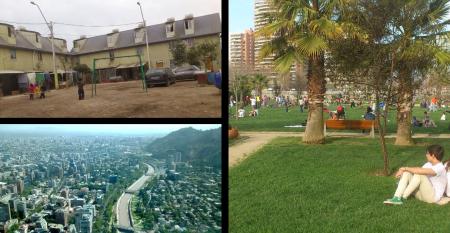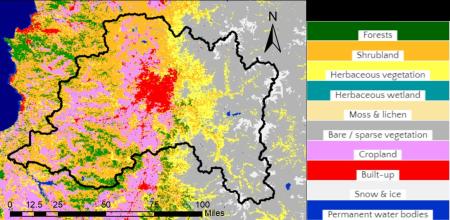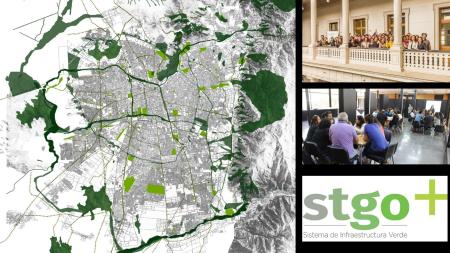
Area characterisation:
Santiago de Chile is in a closed watershed in the central valley surrounded on the eastern side by the high Andean Mountain chain, at the western border by the Coastal Range. The climate is temperate: dry summers with temperatures ranging between 8-30ºC. It is the capital of Chile and the undisputed economic, cultural, and political center of the country. With its almost 7 million inhabitants, it is one of the largest cities in Latin America with a density near 10,000 inhabitants/km2. Its administrative boundaries cover 2,274 km2, of which 617 km2 corresponds to urban land cover: urban development. Chile has been characterized for the implementation of neoliberal policies. Therefore, Santiago´s urban expansion has been poorly regulated and has produced strong social-environmental patterns of segregation. Despite the land-use plan for the Santiago Metropolitan Area (PRMS, Plan Regulador Metropolitano de Santiago), the design and implementation of infrastructure and public works mainly depend on different ministries and departments; the municipalities have the power to make urban regulations.
Objective:
Developing a green infrastructure plan in Santiago as a shared territorial strategy and a means of unifying different stakeholders relevant for decision making and implementation at different spatial scales. This was achieved through a participatory approach including multiple stakeholders, workshops, and collective mapping sessions. This approach identified the principal issues, the justification of the plan, the goals, and the key spatial components.
Images
Potential impacts/benefits:
The main challenges for urban green infrastructure development in Santiago were the extreme sectoral fragmentation and the lack of coordination among public institutions. Thus, the principal impact of the project is the establishment of a participatory planning and governance plan for green spaces in the city. The principal benefits from the project were:
- Increased population & infrastructures protected by NbS.
- Increased amount of green open spaces for residents.
- Increased accessibility to green open spaces
- Changing image of the urban environment.
- Increased communities’ sense of ownership.
- Social inclusion
- Increased stakeholder awareness & knowledge about NbS.
- Improved connectivity and functionality of green and blue infrastructures
Actions:
The actions were conducted in three different steps:
- identification of problems by the stakeholders:
- Social segregation of the city, including newly arise physical and cultural barriers
- A grey city with a low cover and unequal distribution of green spaces
- A disconnected city for mobility and flora and fauna dispersion and movement
- City in a biodiversity hotspot that highlights its relevance for conservation
- A city at risk from increasing climate, volcanoes, and earthquake events
- Pollution puts population and ecosystems at risk, including water, soil, and air pollution problems
- Main strategic goals of the Stgo+ green infrastructure:
- To contribute to the social and spatial integration of the city, and
- To help climate change adaptation in Santiago.
- Main concerns arising by stakeholders:
- Resources for the maintenance of green spaces, especially in low-income municipalities.
- The current inequality of urban green spaces distribution in terms of quantity and quality.
- To assess and make visible ecosystem services provided by the green infrastructure
- Governance and collaborative planning of urban green infrastructure
Transferability of result:
The design and implementation of a green infrastructure plan in Santiago offers an opportunity to catalyse the collective interest in green infrastructure of different types and scales. Also to identify and engage the different actors as public, private, and citizen initiatives with a strategic vision of integrated planning.
To introduce the principle of multifunctionality in projects and plans requires intense intersectoral dialogue and coordinated interventions. In addition, funding is a relevant challenge since there is a deficit of resources for construction, especially for the maintenance of urban green infrastructure in Santiago. This is especially true in low-income municipalities and for initiatives carried out by community organizations.
Lessons learnt:
Opportunities identified included society pressures for having more green spaces; better quality green spaces; better knowledge on the benefits of green infrastructure; alliances with private institutions; using of the green infrastructure concepts by public institutions among others. Additionally, the mapping of relevant stakeholders was completed, including private and public institutions, academia, civil society. Finally, participatory mapping of the potential network was also undertaken.
Organisations:
- Ministry for housing and urbanism of Chile
- Santiago Municipality
- STGO+ http://infraestructuraverdesantiago.cl/
Client:
Santiago de Chile
Design team:
- The Grupo Paisaje-FAU (University of Chile)
- The Ministry for Housing and Urbanism
- The Regional Ministerial Secretariat of the Ministry for Housing and Urbanism
Contacts:
Alexis Vásquez
Universidad de Chile
Cynnamon Dobb.
Centro de Modelamiento y Monitoreo Ecosistemas, Universidad Mayor
Global goals:
-
3. Good Health and well being
-
11. Sustainable cities and communities
-
13. Climate action
-
15. Life on land
NBS goals:
- Enhancing sustainable urbanization
- Restoring ecosystems and their functions
- Urban regeneration through nature-based solutions
- Nature-based solutions for improving well-being in urban areas
- Nature-based solutions and the insurance value of ecosystems
NBS benefits:
- Restoring ecosystems and their functions
- Enhancing sustainable urbanisation
Publications and reports:
- Vásquez, A., Devoto, C., Giannotti, E., Velásquez, P.. (2016). Green Infrastructure Systems Facing Fragmented Cities in Latin America – Case of Santiago, Chile. Science Direct. Procedia Engineering, 161, 1410-1416.
- Amaya-Espinel J.D, Hernández-Garcia J. & Cruz-Suárez M.A. 2021. State of the art, good practices and NbS typology in European Union and Latin America cities. Report D2.1 v1.1. European Union’s Horizon 2020 research and innovation programme under grant agreement no. 867564 tinyurl.com/conexus-project.

